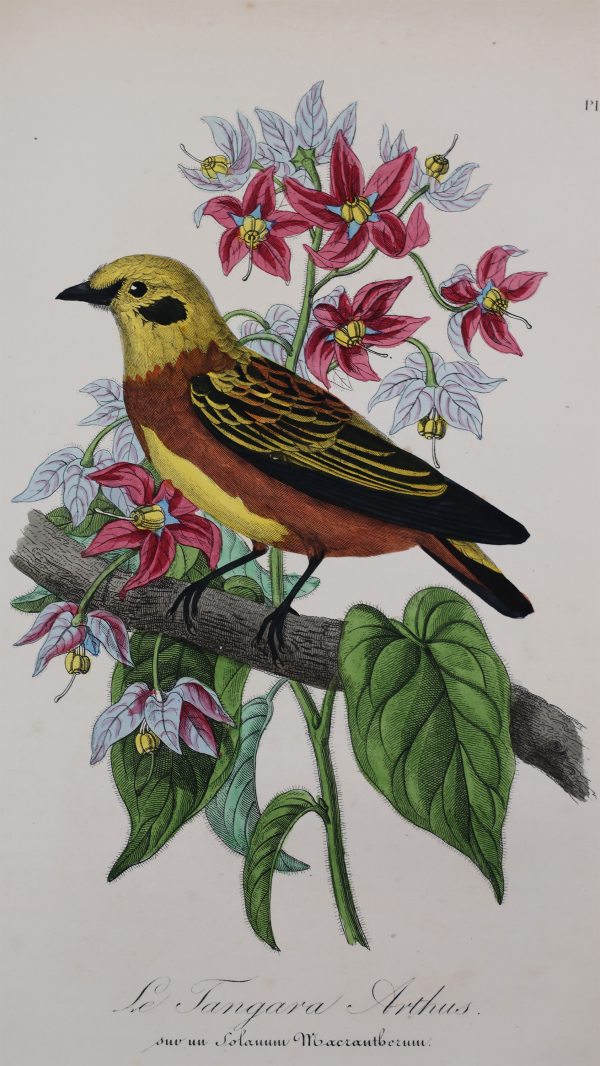Le Maout M. Emmanuel (1799-1877). Les trois règnes de la nature. Règne Végétal. Règne Animal. Paris, L. Curmer, 1852-54. Gervais M. Paul (1816-1879). Les trois règnes de la nature. Règne Animal. Règne Animal. Paris, L. Curmer, 1854-55. M.P. - A. CAP. Muséum d'histoire naturelle. Paris, L. Curmer, 1854
Five volumes, each measuring 269 mm, with approximately 400 pages. Each volume is richly illustrated with numerous in-text engravings and beautiful plates outside the text. The latter amount to a total of 226, of which 106 are splendidly hand-colored contemporaneously and protected by original tissue guards. Attractive publisher's binding in full percaline, entirely decorated with polychrome motifs (cartonnages polycromes). Gilt edges. Some foxing on the pages of a couple of volumes; the binding is well-preserved. This work is rare to find complete in all five parts, especially in a uniform publisher's binding and with such a remarkable and beautiful illustrative apparatus.
Five volumes. 4° (10,59x6,81mm).
Private collection
Some minor foxing on the pages of a couple of volumes, with the binding. The binding of the first volume is slightly more matte; however, the copies are in excellent condition overall, with the bindings appearing particularly fresh.
Since we are not professional conservators or restorers, we urge you to consult with a restorer or conservator of your choice who will be better able to provide a detailed, professional report. Prospective buyers must understand that any statement made by Coradi Rare Finds is merely a subjective opinion.
The works and authors mentioned are significant in the context of 19th-century natural history. Here’s some historical background:
Le Maout: "Les Trois Règnes de la Nature" (1852-54)
Authored by Emmanuel Le Maout, this monumental work focused on the three kingdoms of nature: animals, plants, and minerals.
Published by Curmer in Paris, the book was a synthesis of contemporary knowledge in natural history, designed to be accessible to both scholars and the educated public.
Le Maout’s approach was encyclopedic, presenting a detailed classification of species and geological formations, aligning with the scientific standards of the mid-19th century.
Gervais: Contribution to "Les Trois Règnes de la Nature" (1854-55)
Paul Gervais, a French zoologist and paleontologist, contributed to the continuation and enhancement of the same title after Le Maout's initial volumes.
Gervais was known for his expertise in vertebrate paleontology, and his contributions often highlighted evolutionary insights and fossil evidence that helped bridge modern species with ancient ones.
M.P. - A. Cap: Muséum d'Histoire Naturelle (1854)
This work was also published by Curmer and likely related to the Muséum national d'Histoire naturelle in Paris, one of the world’s leading centers of natural history research.
The publication reflected the museum’s role in advancing scientific understanding and its influence on natural history literature.
Historical Context
The mid-19th century was a time of significant advancement in natural sciences. It was the pre-Darwinian period (Darwin’s On the Origin of Species was published in 1859) when classification systems like those by Linnaeus were being expanded and refined.
These works were part of a broader movement to make scientific knowledge accessible through lavishly illustrated and comprehensive publications.
Paris, as a center of scientific innovation, played a key role, with institutions like the Muséum d'Histoire Naturelle contributing to the spread of natural history studies.
These publications remain important both for their scientific content and as historical artifacts illustrating how science was communicated in the 19th century.




